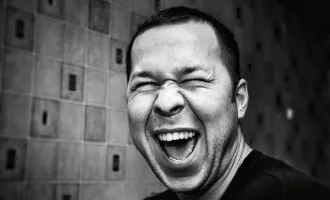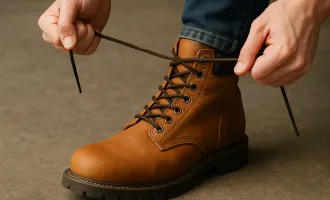
This Date in UCSF History: A Visit to Ground Zero
Originally published in Synapse on September 20, 2001. [Editor’s Note: Joshua Gordon is an alumnus of UCSF, who received his PhD in 1995 and his MD in 1997.] On Wednesday, September 12, 2001, at 2:30 p.m., two colleagues and I decided to go down to the World Trade Center to see what we could see and help how we could help.
After first signing up with the Red Cross, who had more mental health worker volunteers than they could deal with at the time, we took the A train to West 4th St., as far south as one could go in Manhattan. We got out and walked down 6th Ave. to Houston.
There, our MD IDs got us through the first checkpoint. From Houston to Canal, we could see the smoke rising above lower Manhattan, and smell it in the air. We saw many pedestrians, mostly non-official; apparently, they were allowing residents to go to their homes in this area.
Skateboarders could be seen, bicyclists, too. At the next checkpoint, Canal, the smoke seemed higher in the air, the smell thicker, and many of the police guarding the avenues were wearing masks.
Again, we showed our IDs, said we were psychiatrists, and they let us through. As we walked further, the pedestrians were fewer, and all official. The only traffic was the occasional emergency or construction vehicle.
The smoke got thicker, still high in the air, though; breathing was not a problem. Soot and ash were everywhere, coating the cars, sidewalks and streets. As we neared Chambers Street, we saw it; the red-brown wall of Building Seven rising 40 feet above the street, crumpled over; two strong streams of water arching out over the mound onto the rubble behind; smoke still emanating from the wreckage that had been the World Trade Center.
The buildings around were smothered in wreckage; mostly ash and bits of yellow-mesh insulation. We saw no bodies, alive or dead.
Next we headed west, where supposedly there was a triage center. There, from the West Side Highway in front of the American Express building (I think it was Vesey Street), we could see trucks lined up for a good mile to the north, and to the south: carnage.
The bridge across the West Side Highway had collapsed, and for good reason. Sitting on top of it, and to the south, were 50-foot mounds of rubble from one of the towers; large pieces of debris had obviously fallen over the highway.
Parts must have stricken the Amex building next door, which had pieces of its southeast corner shorn off. Further south, all of the windows of the World Financial Center were blown out, and bits of its facade were missing.
Smoke obscured the view into the former WTC’s plaza, but every once in a while the wind cleared it away, revealing just a few shards of the skin of the towers sticking up, leaning every which way.
In the foreground, three cranes were at work pulling down the wreckage, shoveling it into dump trucks. This did not resemble, in the least, a rescue operation. This resembled, absolutely, a demolition.
As we neared Chambers Street, we saw smoke still emanating from the wreckage that had been the World Trade Center. Windows were out all over the place. Cars here and there were bombed out — all the glass sitting on the seats, covered in an inch of ash and miscellaneous trash. And papers everywhere, like a college dorm room during finals week, many of them burned brown around the edges.
At Chambers Street, we were greeted by rifle-wielding national guardsmen who scrutinized our IDs very carefully before letting us pass. Later, a guardsmen told us they were most concerned about not letting reporters beyond Canal Street.
We found some Salvation Army volunteers handing out sandwiches and drinks to any and everyone; Con Ed employees walking about; construction vehicles moving around, and firemen and policemen coated in ash. All were wearing masks against the soot, which was beginning to make my eyes itch a bit, and my throat dry. We saw cranes attacking the wreckage of Building Seven.
We got some masks from some firefighters and moved closer in, caddy corner from the WTC on the West Side Highway. There, we could clearly see one of the smaller WTC buildings, six or seven stories, crushed right in the middle. The building across the street had lost all of its windows and sustained significant exterior damage. The Amex building had lost all of its lower windows, and although we couldn’t see it, it looked as if a piece of one of the towers had crashed into its lobby to the south.
We walked west, along the river, around the World Financial Center to the site of a south triage station we had been told about by some doctors we saw walking north. The trees of the Battery Park City complex were not green but gray. Ash covered the plaza, and each of the yachts in the harbor. The residential buildings of Battery Park City looked intact, and, from West, the World Financial Center also looked better than it did from the east.
As we headed around the small harbor, we saw a bunch of workers on the other side running away from the damage to the water’s edge. Some Orthodox Jews, chaplains from Brooklyn who had come through the Battery Tunnel that morning, came running past us, and told us that the rescue effort had been halted to the south because of fear that a large black building to the south of the WTC would collapse.
We walked out onto a dock in the Harbor and saw it, a wide, 50-story building had sustained a triangular hole in its Northern side, perhaps twenty stories tall, a half-city block wide, and maybe 20-30 feet deep. It didn’t collapse immediately, or the rest of the time we were down there, but it surely would have to come down at some point.
Cut off from the southern triage center by the boat harbor (going around it was dangerous, as it required going a bit too close to the aforementioned black building with a gash down its middle), we trudged back through the ash to Stuyvesant High School, a few blocks north of Ground Zero, and a staging area/triage area for the northern site.
On the way, we walked through the Battery Park City, beautiful and green on a brilliant day, the sun shining. On any other such day, I would have been overjoyed to simply lie down in the green grass and gaze at the water and the sky. But not today.
We walked through more soot to Stuyvesant High, which has a magnificent granite accented lobby, now covered in soot. Temporary lighting made it dim but serviceable inside for the 50-60 doctors and nurses who manned the 10-12 bed first aid facility inside; while I was there, one emergency worker was having his eyes washed out. Hundreds of fire fighters, policeman, and even some dogs with the canine corps, were sitting and walking about.
Several teams of volunteers, some from the Salvation Army, some from the “Scientology Volunteer Mission,” as their bright yellow t-shirts told us, distributed lots of hot and cold food and drinks. Soot and ash were everywhere.
We went into the auditorium, where a handwritten sign read, “Mental Health counseling available,” was placed right next to another sign telling the K-9 officers where to take their dogs for care.
There we asked to help, but no one seemed to have anything for us to do. We did finally run into a psychiatrist who said she was trying to help but most of those involved were resistant.
I did talk to an EMT who broke down after the latest of buildings threatened to collapse; she had been at the site since 9:00 the previous morning. We got her on an ambulance to Chelsea Piers, the northernmost staging area for the relief and rescue effort, on 23rd Street.
I also talked to some firefighters who expressed pessimism that any survivors would be found, though rumors of people trapped in the mall beneath the towers communicating with cell phones were spread around.
Most of the firefighters had been there since the day before, with a break for a few hours here or there to go home to sleep. Police had the same story, although the few I spoke to had slept in their station houses.
Some had been close to the wreckage, seen bodies, etc.; most said only that the bodies were being ferried over the river to New Jersey, and that they hadn’t been close enough to see much.
They all said they were missing friends.
We were there for a couple of hours in total, before having to head back; I had a shift to put in at the ER that night for grief counseling (although patients presenting to Columbia, 200 blocks to the north, have been few so far).
We walked north along the West Side Highway, passing truck after truck, crane after crane, bus after bus. At Canal, many reporters and TV cameras were lined up, getting shots of the smoke rising above the WTC site.
At Houston, hundreds of onlookers peacefully gazed southwards. Halfway between, two New Yorkers held up hand-drawn signs for the laden dump trucks heading north: “Thanks,” they read.
The truckers uniformly tooted their horns in appreciation of the gesture.



